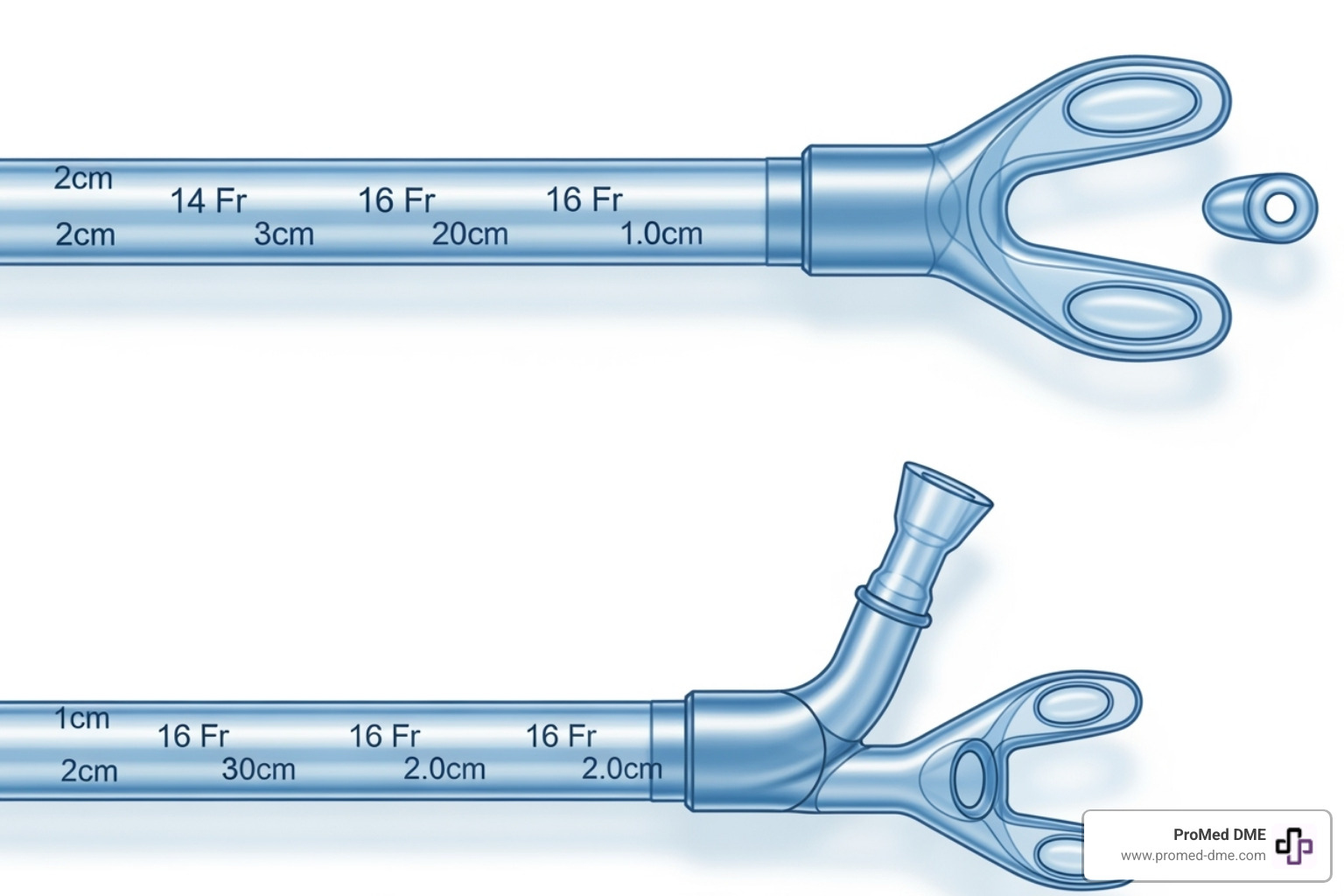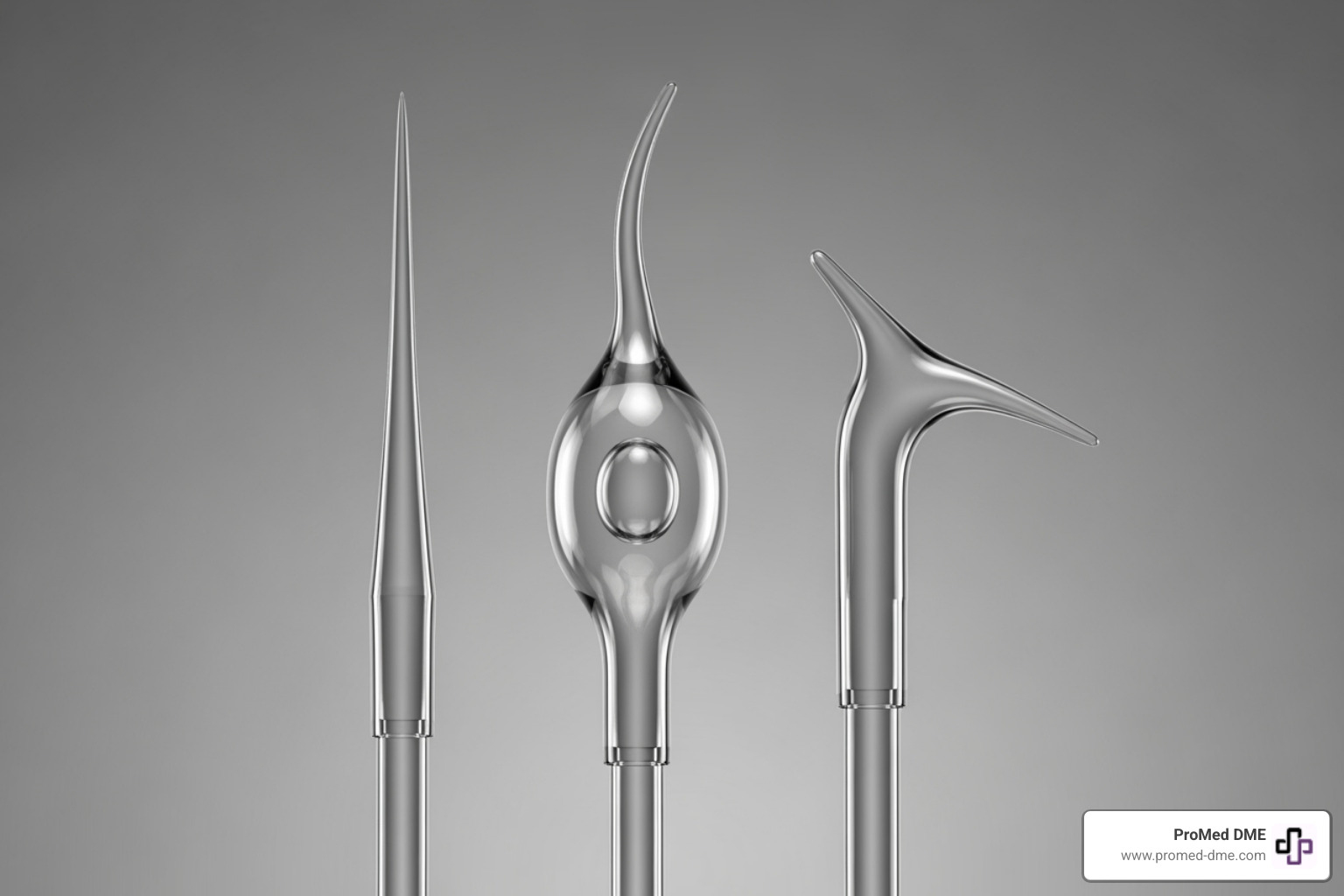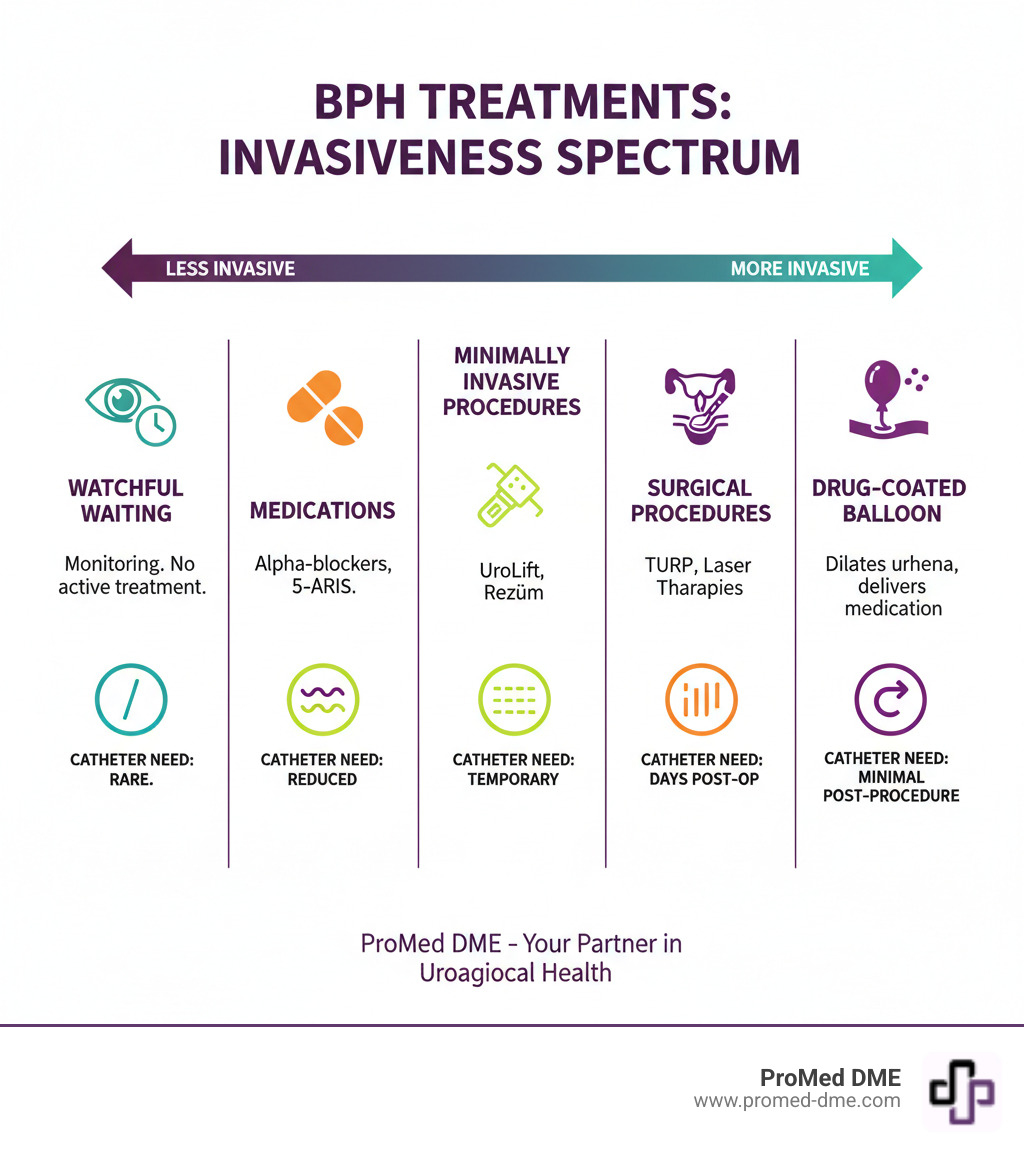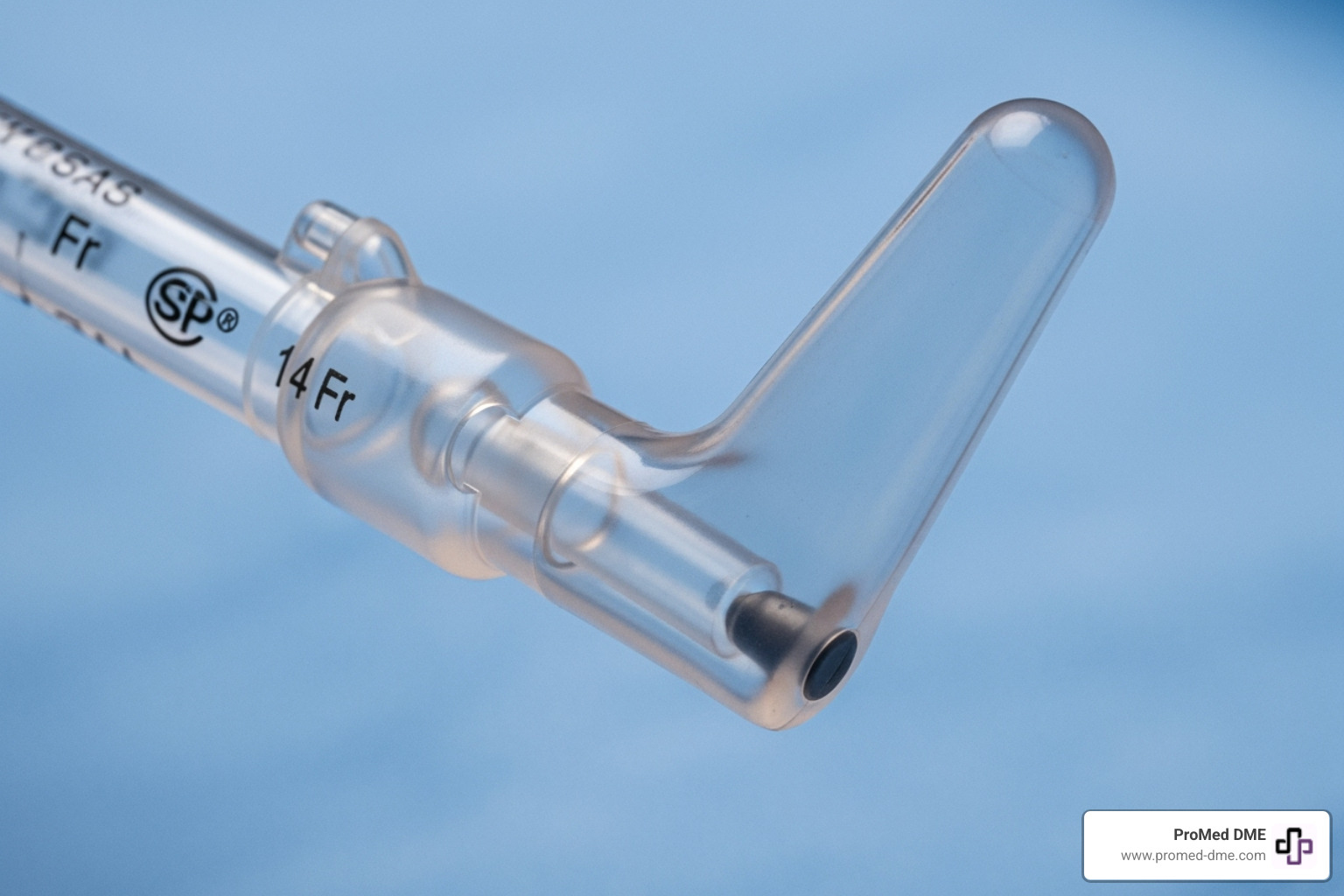Beyond the Basics: Special Catheters for Enlarged Prostates

Why Understanding Catheter Options Matters When You Have an Enlarged Prostate
What catheter is used for enlarged prostate conditions? The short answer: Coudé catheters are the specialized solution most often recommended for men with benign prostatic hyperplasia (BPH).
Quick Answer: Catheter Types for Enlarged Prostate
| Catheter Type | Best For | Key Feature |
|---|---|---|
| Coudé Catheter | Enlarged prostate (BPH) | Curved tip steers prostatic obstruction |
| Tapered Coudé | Standard BPH cases | Gentle curve for easier passage |
| Olive Tip Coudé | Post-injury healing | Ball-shaped tip for damaged urethras |
| Tiemann Coudé | Severe obstruction | Longer, more flexible curve |
If you're among the up to 50% of men between ages 51 and 60 affected by an enlarged prostate, you've probably experienced those frustrating symptoms: weak urine stream, frequent nighttime bathroom trips, or difficulty emptying your bladder completely. When these symptoms become severe or lead to urinary retention, catheterization may become necessary.
The challenge? A standard straight-tip catheter often can't steer past an enlarged prostate. That's where specialized catheters come in.
Why standard catheters struggle with BPH:
- The enlarged prostate creates a curved, narrow path
- Straight catheters can cause urethral trauma
- Risk of creating false passages in the urethra
- Increased patient discomfort and pain
The good news is that medical device innovation has created catheter designs specifically for this common condition. Understanding your options helps you work with your healthcare provider to find the most comfortable, effective solution.

What catheter is used for enlarged prostate terms simplified:
Understanding BPH and How It Affects Urination
Your prostate is a small gland below the bladder that wraps around the urethra, the tube that carries urine out of your body. Its main job is producing seminal fluid. As men age, the prostate often grows—a non-cancerous condition called Benign Prostatic Hyperplasia (BPH). It's very common, affecting up to 50% of men between ages 51 and 60, with rates increasing with age, according to the National Institute of Diabetes and Digestive and Kidney Diseases.
When the prostate enlarges, it squeezes the urethra, causing urethra constriction. Think of it like a clamp tightening around a garden hose. This blockage makes it difficult for urine to flow freely, leading to symptoms that can significantly impact your quality of life:
- Weak stream or trickling
- Frequent urination, especially at night
- Difficulty starting to urinate
- Straining or feeling that the bladder isn't empty
- Sudden, intense urges to urinate
These symptoms occur because the bladder has to work harder to push urine through the narrowed passage. In severe cases, BPH can cause Acute Urinary Retention (AUR), a complete and painful inability to urinate. This is a medical emergency where knowing what catheter is used for enlarged prostate is critical. Understanding this physical blockage explains why specialized catheters with a curved tip are necessary to steer the urinary path safely.
What Catheter is Used for an Enlarged Prostate? The Coudé Catheter Solution
When an enlarged prostate blocks urine flow, a catheter is needed to drain the bladder. However, a standard straight-tip catheter often fails with BPH, risking pain and urethral damage. So, what catheter is used for an enlarged prostate? The answer is the Coudé catheter.

The Coudé (pronounced "koo-DAY") catheter has a curved tip specifically designed to steer the male urethra when a prostatic obstruction is present. An enlarged prostate creates angles and lifts the bladder neck, making a straight path impossible. The Coudé's curved tip glides past the obstruction, allowing for successful catheterization with improved comfort and a lower risk of trauma. Studies show that a Coudé catheter is often successful where a straight catheter has failed.
The Different Types of Coudé Catheter Tips
Not all Coudé tips are the same. A healthcare provider will choose the best one for your anatomy.

- Tapered Tip: This is the most common type, with a short, gentle curve that works for most standard BPH cases.
- Olive Tip: This tip has a small, rounded ball shape at the end. It's used to steer urethral strictures or scar tissue, as the ball shape helps gently dilate narrow spots.
- Tiemann Tip: Featuring a longer, more flexible curve, this tip is designed for severe obstructions or complex anatomy where other tips can't pass.
Your provider will select the right coude tip catheter to ensure the safest and most effective solution for your needs.
Choosing the Right Catheter for BPH: What to Know
Beyond the Coudé tip, several other factors are crucial when selecting a catheter for BPH. This decision should always be made with your healthcare provider.
- Catheter Type: Catheters are used differently. Intermittent catheters are inserted to drain the bladder and immediately removed, a process repeated several times a day. Foley (indwelling) catheters remain in the bladder for continuous drainage, held by a small balloon, and are often used post-surgery. For general information on care, see MedlinePlus.
- Size (French Size): Catheter diameter is measured in French (Fr) units. For BPH, larger sizes (20-24 Fr) are often preferred over standard sizes (16-18 Fr) because they are more rigid and less likely to kink while passing the prostate.
- Material: The material affects comfort and use. PVC is a firm material common for intermittent catheters. Silicone is more flexible and biocompatible, making it ideal for indwelling catheters. Hydrophilic-coated catheters have a special coating that becomes extremely slippery when wet, significantly reducing friction and improving comfort during insertion.
- Lubrication: Proper lubrication is essential for safe and comfortable insertion. Many catheters are pre-lubricated or have a hydrophilic coating. Otherwise, a generous amount of sterile, water-soluble lubricant must be used to minimize friction and the risk of urethral damage.
Following your provider's recommendations and FDA safety guidelines is key to comfortable and effective catheterization. At ProMed DME, we provide quality supplies and expert guidance to help make catheterization a manageable part of your routine.
When is Catheterization Recommended vs. Other BPH Treatments?
Catheterization is a crucial intervention for BPH, but it's not always the first line of treatment. It's typically recommended in specific scenarios:
- Acute Urinary Retention (AUR): A medical emergency where you suddenly cannot urinate at all. A catheter provides immediate relief.
- Chronic urinary retention: When the bladder consistently fails to empty completely, a catheter is used to prevent kidney damage, infections, and bladder stones. This may involve intermittent self-catheterization.
- Post-surgery recovery: A catheter is often used temporarily after prostate procedures to allow the area to heal while ensuring proper urine drainage.
- Diagnostic purpose: A catheter can be used to measure post-void residual (PVR) volume—the amount of urine left in the bladder after urination.
Catheterization Alternatives: A Broader Look at BPH Treatments
Fortunately, many other BPH treatment options are available. Treatment often starts with the least invasive approach.
- Lifestyle Changes: For mild symptoms, limiting fluids before bed and reducing caffeine and alcohol can help.
- Medications: Alpha-blockers relax prostate muscles to improve flow, while 5-alpha reductase inhibitors can shrink the prostate over time.
- Minimally invasive procedures: Options like UroLift, Rezūm, and the Optilume BPH Catheter System use different technologies to open the urethra with minimal downtime.
- Surgical procedures: For severe symptoms, procedures like TURP (Transurethral Resection of the Prostate) or laser therapies (HoLEP, PVP) remove prostate tissue to clear the obstruction.

The key takeaway is that catheterization is part of a broader treatment strategy custom to your specific condition.
What are the potential side effects of catheter use for an enlarged prostate?
While catheters are vital, they come with potential risks. Awareness helps in prevention and early management.
- Urinary Tract Infections (UTIs): The most common complication. Proper hygiene and sterile technique are the best defenses.
- Bladder spasms: Uncomfortable bladder cramps that can often be managed with medication.
- Urethral trauma: Irritation or injury from improper insertion. Using the correct Coudé tip and size minimizes this risk.
- Leakage: Urine bypassing the catheter can be caused by blockages, spasms, or incorrect sizing.
- Blood in your urine (hematuria): Minor bleeding is common after insertion, but significant or persistent blood requires medical attention.
Following your provider's instructions is crucial for minimizing these complications. For more information on catheter care, you can visit MedlinePlus.
Frequently Asked Questions about Catheters and BPH
Here are answers to some of the most common questions about using catheters for an enlarged prostate.
How long is a catheter typically used for BPH-related issues?
The duration depends entirely on the reason for catheterization:
- For Acute Urinary Retention (AUR): Typically short-term, from a few days to a couple of weeks, to allow swelling to decrease or medications to take effect.
- Post-operative care: The timeframe is set by your surgeon, often around two weeks after prostate surgery, to allow for healing.
- Intermittent catheterization: This can be a long-term management strategy. You use a new catheter to drain your bladder several times a day and then dispose of it.
- Long-term indwelling catheters: Reserved for men who cannot manage intermittent catheterization or are not candidates for other treatments. These are changed regularly by a healthcare professional.
How does a healthcare provider diagnose BPH?
Diagnosing BPH involves several steps to assess your symptoms and rule out other conditions. The process usually includes:
- A review of your symptoms, often using the International Prostate Symptom Score (IPSS).
- A Digital Rectal Exam (DRE) to feel the prostate's size and texture.
- Urine and blood tests, including a PSA (Prostate-Specific Antigen) test.
- Functional tests like a urinary flow study or a postvoid residual (PVR) test to see how well your bladder is emptying.
In some cases, more advanced tests like an ultrasound or cystoscopy may be needed. The National Institute of Diabetes and Digestive and Kidney Diseases offers more details on diagnosis.
What are the main complications of using a catheter with an enlarged prostate?
While Coudé catheters are designed for safety, potential complications exist. Awareness is key to prevention.
- Urinary Tract Infections (UTIs): The most common risk. Sterile technique and good hygiene are critical for prevention.
- Urethral strictures: Scar tissue can form inside the urethra with long-term use, causing it to narrow.
- Bladder stones: Can form in the bladder, especially with long-term indwelling catheters.
- Discomfort and pain: Some irritation is common initially, but the Coudé design helps minimize this.
- Leakage around the catheter: If urine bypasses your catheter, it might signal a blockage or bladder spasms. Let your provider know.
- Paraphimosis: In uncircumcised men, the foreskin can become trapped if not returned to its normal position after catheterization. This is a medical emergency.
Many of these complications are preventable with proper care. If you experience concerning symptoms like fever, significant pain, or large blood clots, contact your doctor immediately.
Your Partner in Managing BPH with Confidence
Living with an enlarged prostate presents challenges, but here's the truth: you're not facing them alone. Throughout this guide, we've explored what catheter is used for enlarged prostate management – from understanding how Coudé catheters' curved tips steer past prostatic obstruction to learning about the different tip designs (tapered, olive, and Tiemann) that address varying degrees of urethral complexity.
Knowledge is power, and now you're equipped with the information you need to have meaningful conversations with your healthcare provider about your options. Whether you're managing acute urinary retention, recovering from surgery, or using intermittent catheterization as part of your daily routine, the right catheter makes all the difference in your comfort and quality of life.
This is where ProMed DME comes in. We understand that dealing with BPH symptoms isn't just a medical issue – it affects your daily life, your confidence, and your peace of mind. That's why we've built our company around something simple but powerful: treating you like family.
When you work with us, you're getting more than quality urological supplies. You're getting free shipping across the United States, so you never have to worry about unexpected costs. You're getting a dedicated nurse on staff who's ready to answer your questions, walk you through proper catheter use, and provide the kind of personalized support that makes a real difference. And we work with most insurance plans to help minimize your out-of-pocket expenses, because managing your health shouldn't break the bank.
From specialized Coudé catheters designed specifically for prostatic obstruction to hydrophilic-coated options for maximum comfort, we carry the products healthcare providers trust and patients rely on. We're based in Stuart, Florida, but we serve folks across the entire country.
Your journey with BPH doesn't have to limit your freedom or your lifestyle. With proper medical guidance, the right supplies, and a support team that genuinely cares, you can manage your symptoms with confidence.
Ready to take the next step? Find the right urology supplies for your needs at ProMed DME today. We're here to help you live comfortably and confidently – because that's what partners do.
Related Resources & Articles
Stay informed with our informative blog posts.
Discover the ProMed Advantage
& Try Our Products
We offer free shipping and legendary customer service to ensure you receive the
best DME products for your needs.


